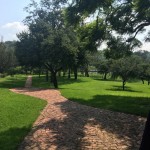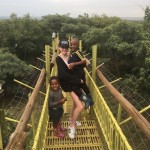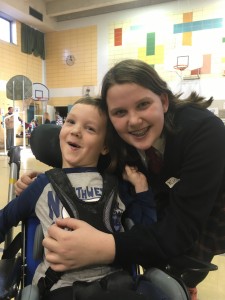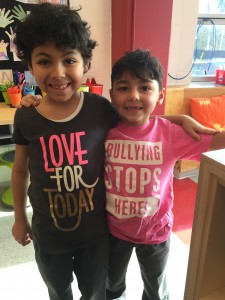 I arrived in South Africa two weeks ago to attend St Stithians Girls’ College. So far it has been an amazing experience. Johannesburg has many nicknames such as Joburg, Jozi and the City of Gold. It is referred to as the City of Gold because of all the gold mining that has left the city with gold sand.
I arrived in South Africa two weeks ago to attend St Stithians Girls’ College. So far it has been an amazing experience. Johannesburg has many nicknames such as Joburg, Jozi and the City of Gold. It is referred to as the City of Gold because of all the gold mining that has left the city with gold sand.
After about 21 hours of travelling (including one 15-hour flight), I arrived in South Africa to meet my host family. I met my exchange, Edith, her parents and her three siblings who are 10, 5 and 4. Everyone here is very welcoming and it is completely normal to greet a person you have never met before with a hug (which took some getting used to).
Living in South Africa is very different from living in Canada. All middle-upper class families live behind walls topped with fences of barbed wire, electric wire or both. The less fortunate people live in places called townships where people build houses from any scrap material they can find and they all live in extremely close proximity, often fitting millions of people into tiny plots of land. The main townships of Johannesburg are Soweto, Cosmo, Diepsluit and Alex.
Many languages are spoken here, the primary ones being English, Afrikaans, Sotho and Zulu. I have learnt a lot of new South African words such as “eina” being the word they use instead of ouch when they are in pain or “woza” meaning come here.
School here is very different from LCC. Everyone brings their own lunches, we are allowed our phones in class and we have to attend chapel weekly because it is a religious (Methodist) school. I am taking grade 10 classes but I am finding that a lot of what they are learning is similar to what we are learning at LCC in grade 9. Also, to pass a test you need 33% meaning that it is very hard to fail a test.
School pride is very important at Saints. On Thursday I watched the inter-house aquatics tournament. The four houses: Trewen, Cambourne, Stratton and Kenwyn competed in diving, water polo and swim racing. Everyone got dressed in their house colours and cheered on their houses with organized cheers called war cries that are accompanied by drums.
I have had the experience of visiting a game reserve in rural South Africa. Nature here is referred to as the bush. I got to see many animals such as lions, giraffes, ostriches, cheetahs, impalas, hyenas and wildebeests. We were able to get very close to these animals and it was amazing to be able to see them in such close proximity.
So far, South Africa has been a great experience and I am glad that I chose to go on exchange and visit this amazing country. – Natasha Ryan ’19, Exchange Student at St Stithians Girls’ College






 I have been living in Bogota, Colombia for a week and half and it has felt like the longest 11 days of my life. I feel like I’ve lived here my whole life and that is because my host family and friends in school have made me feel so welcome and at home.
I have been living in Bogota, Colombia for a week and half and it has felt like the longest 11 days of my life. I feel like I’ve lived here my whole life and that is because my host family and friends in school have made me feel so welcome and at home.





 During our trip to the Mackay Centre, we learned many valuable lessons…
During our trip to the Mackay Centre, we learned many valuable lessons… After twenty-two hours of flying and layovers, I finally got to Sydney Kingsford Smith Airport on Sunday, February 26. I got my bag in less than 15 minutes and met my exchange, Sarah, at the arrivals gate. When we stepped outside, it was very humid and I was thankful for the shorts I put on before landing. I slept for about ten hours on the plane so by the time I landed, I wasn’t tired, and I had enough energy to walk around.
After twenty-two hours of flying and layovers, I finally got to Sydney Kingsford Smith Airport on Sunday, February 26. I got my bag in less than 15 minutes and met my exchange, Sarah, at the arrivals gate. When we stepped outside, it was very humid and I was thankful for the shorts I put on before landing. I slept for about ten hours on the plane so by the time I landed, I wasn’t tired, and I had enough energy to walk around. It was Pink Shirt Day on Wednesday all across Canada. It’s an initiative that was started some years ago by two courageous boys in a high school in Nova Scotia. They openly and actively defended a new student, a younger boy in grade 9, who was taking heat from some students for wearing pink. In an act of solidarity and support, the two senior boys got their hands on dozens of pink t-shirts and issued them to boys as they entered the school one morning.
It was Pink Shirt Day on Wednesday all across Canada. It’s an initiative that was started some years ago by two courageous boys in a high school in Nova Scotia. They openly and actively defended a new student, a younger boy in grade 9, who was taking heat from some students for wearing pink. In an act of solidarity and support, the two senior boys got their hands on dozens of pink t-shirts and issued them to boys as they entered the school one morning.